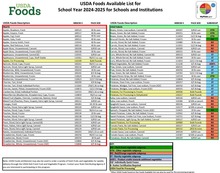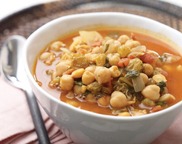|
This is the beginning of a series of e-letters that will highlight all the food categories available on the USDA Foods in Schools Foods Available List. Stay tuned for future Spotlight on Schools e-letters to learn more about USDA Foods!
News & Notes

USDA Foods Available List for SY 2024-25 Has Been Published
Items have been temporarily removed due to lack of product availability.
-
100227 – Orange Juice, Unsweetened, Cartons, Frozen – 70/4 oz carton
-
110651 – Orange Juice, Unsweetened, Cups, Frozen – 96/4 oz cup
Item has been removed due to changes in processor needs and product availability.
-
100443 – Oil, Vegetable – Bulk Pounds
-
110921 – Chicken, Grilled Fillet-Style, 2.0 MMA, Cooked, Frozen – 6/5 lb. or 3/10 lb. bag.
-
The product description, specification, and Product Information Sheet have been updated to clarify that the product is not a whole muscle breast, but instead made from whole muscle breast pieces that are formed into a fillet-style shape. The product remains the same as what has previously been supplied.
-
110931 – Eggs, Patties, Cooked, 1.0 MMA, Round, Frozen – 25 lb. case à 111751 – Eggs, Patties, Cooked, 1.0 MMA, Round, Frozen – 25 lb. case
-
Updated material code reflects a change in truckload weight from 39,600 lbs. (1,584 cases) to 36,750 lbs. (1,470 cases). No other changes were made to the specification.
-
110398 – Yogurt, High-Protein, Vanilla, Chilled (K) – 6/32 oz tub à 111750 – Yogurt, High-Protein, Vanilla, Chilled (K) – 6/32 oz tub
-
Updated material code reflects a change in truckload weight from 34,320 lbs. (2,860 cases) to 35,280 lbs. (2,940 cases) and pallet configuration from 60 cases per pallet to 130 cases per pallet. No other changes were made to the specification.
-
110396 – Cheese, Mozzarella, Low Moisture Part Skim, String, Chilled – 360/1 oz package
- The product will be available to order in less than truckload quantities in addition to full truckload quantities. The minimum order quantity is half a truckload (840 cases), which can be split between up to 3 delivery locations with a minimum order of 210 cases per delivery location.
The USDA Foods List of Materials SY 2024-25 was also updated to provide an estimated price per pound, per case, and per truck for all USDA Foods items available. This information can be used by States and school districts to estimate the entitlement value of USDA Foods orders placed for the upcoming school year.
USDA Foods Processing Reminder
The USDA Foods Available List (FAL) highlights products that are supplied in bulk for further processing in yellow. However, other USDA Foods found on the FAL not highlighted in yellow can also be used for the processing program. Contact your State Distributing Agency if you are interested in utilizing other USDA Foods for further processing.
|

Request for Applications for the Healthy Meals Incentives Initiative School Food System Transformation Challenge Sub-Grants Have Been Released
On February 1, one of the four cooperators for FNS’s Healthy Meals Incentives Initiative School Food System Transformation Challenge Sub-Grants, Illinois Public Health Institute (IPHI) released two Requests for Applications (RFA). IPHI’s Lake Michigan School Food System Innovation Hub has also opened applications for Spark Awards and Innovation Collaborative Awards. To learn about these opportunities for the Lake Michigan Region (Illinois, Indiana, Michigan, and Wisconsin) that close on April 30, visit the Innovate School Food website. Full Plates Full Potential (FPFP) will release their RFA for the School Food System Innovation Grant for Maine in early March with a closing date of May 1. Visit the Maine School Meal Grants website to stay in the know.
|
Featured Foods

Seafood in Schools
Seafood, which includes fish and shellfish, is a protein food that credits as a meat/meat alternate in Child Nutrition Programs. Seafood provides essential omega-3s, vitamins, and minerals, to support students' brain health, heart health, and overall wellness.
Both direct delivery products can be used for a variety of recipes, such as fish tacos, fish and chips, fish sandwiches, or rice bowls. Check out these tasty recipes for ideas on how to add these products to your school menus:
The non-profit Seafood Nutrition Partnership, a USDA MyPlate Partner, offers free resources, recipes, posters and more to help schools serve more seafood in schools. For more information, visit the Seafood Nutrition Partnership website.
|

Nuts and Seeds through USDA Foods
The USDA Foods in Schools Foods Available List offers peanuts, peanut butter, and sunflower seed butter for states to make available for school districts to use in school and summer meals. Many schools offer daily peanut butter and jelly sandwiches as an alternative to the main entrée, while the individual portion packs are a great way to include a meat/meat alternate at breakfast.
Nuts and seeds offer a variety of beneficial nutrients to your students. With fiber and protein, nut and seed butters keep kids full and energized to tackle whatever the school day throws their way. Nuts and seeds have unsaturated fats, which may help lower the risk of heart disease and support a healthy brain.
For those schools that are nut-free, sunflower seed butter is a great alternative to peanut butter that is kid-friendly and versatile in school meals. Available in a 5-pound tub (100935) and kosher-certified, sunflower seed butter can be used beyond the sunflower seed butter and jelly sandwich. Check out how peanut and sunflower seed butter are used in the “Offering Meats and Meat Alternates at School Breakfast Guide.”
|

Beans: A Magical Ingredient for Heart Health
Are you ready to dive into the wonderful world of beans? These versatile legumes are not only packed with protein, fiber, vitamins, and minerals but also happen to be low in fat, sodium, and cholesterol. February is American Heart Month, so what better way to celebrate than by serving heart-healthy meals starring beans? According to the American Heart Association, swapping out red meat for plant-based proteins like beans can help lower blood cholesterol levels, reducing the risk of heart disease. The USDA Foods Available List for School Year 2024-2025 offers over a dozen different types of beans in both dried and canned variations, including lima, black, garbanzo, great northern, refried, red, and pinto beans. Here are some five-star recipes featuring beans:
Cuban Black Beans and Rice: Black beans simmered in spices and paired with rice.
Spanish Chickpea Stew: Packed with chickpeas, veggies, and aromatic spices.
|
Webinar Round-Up

Safe Meals, Healthy Kids: Food Safety Tips for Summer Meals
Summer will be here soon! Do you need a summer meal program refresher? On January 31, 2024, FNS hosted a national webinar for summer meal providers: “Safe Meals, Healthy Kids: Food Safety Tips for Summer Meals.” It included presentations on food safety and summer meal policies, followed by sharing and Q&A opportunities. This webinar, intended for summer meal providers and others providing training for summer meal operations, was recorded and is available to view here.
|
Technology Synopsis
New Stop Order Percentage Options for SDAs in WBSCM
With the January 2024 release, the Web-based Supply Chain Management (WBSCM) system has new options for entitlement tolerance management to support State Distributing Agencies (SDAs) who have rolled down WBSCM to their respective recipient agencies (RAs). In addition to the previously available values of 100% and higher, SDAs are now able to select the following Stop Order percentages: 80%, 85%, 90%, and 95%. If an SDA chooses to implement a Stop Order percentage, RAs will not be able to place any additional orders once the selected entitlement percentage threshold has been met. These new options are available for all programs that currently have the Stop Order percentage function.
The Stop Order Percentage drop-down menu with the new percentage options.
All monthly changes are documented in the Release Notes, which may be accessed in WBSCM at Help > Training > Release Notes.
For questions about WBSCM, please contact the WBSCM Service Desk or call (877) 927-2648.
WBSCM User Feedback Sessions
The USDA Foods Technology Branch hosts monthly WBSCM user feedback sessions for State and local/recipient agency users. These sessions are intended to identify challenges and opportunities for potential enhancements and future trainings in WBSCM. The meetings are held on the second Tuesday of each month; the next meeting is scheduled for Tuesday, March 12, 2024, at 3 PM ET. If you are interested in participating in future sessions, please contact Samantha Escamilla.
|